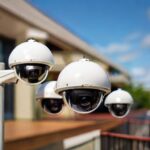Job site cameras have become an increasingly common fixture on construction sites, factories, warehouses, and other industrial workplaces. Companies install job site cameras for a variety of reasons – to monitor worker safety, prevent theft, oversee operations, and gather video evidence in case of accidents or disputes.
But the use of worksite surveillance cameras raises concerns about worker privacy and trust. explore the pros and cons of using job site cameras, including best practices for optimal implementation.
What Are Job Site Cameras?
Job site cameras, also called construction cameras or workplace cameras, are surveillance cameras installed at indoor and outdoor work facilities and construction projects to provide visual oversight of operations. They may include fixed security cameras, pan-tilt-zoom (PTZ) cameras that can be controlled remotely, wide-angle cameras for broad coverage, and 360-degree “fisheye” cameras that eliminate blind spots.
Cameras can be wired into a closed-circuit TV (CCTV) system or connected wirelessly via WiFi or cellular data networks. Video from job site cameras may be monitored in real-time or recorded to a digital video recorder (DVR) or network video recorder (NVR) for storage and review. The footage can be accessed onsite or offsite via apps and remote login.
Why Companies Install Job Site Cameras
There are several reasons companies install surveillance cameras at worksites and construction projects:
- Monitor worker safety – Quickly identify risks like unsafe behaviors, equipment issues, or hazardous conditions using job site cameras. Use footage to retrain workers and prevent accidents.
- Prevent theft – Deter theft of equipment, materials, and tools by having job site cameras visibly in place. If thefts do occur, review footage to determine what was taken and who was involved.
- Oversee operations – Construction project managers can use cameras to oversee progress and workflow without being onsite. Identify delays, problems, and productivity via worksite cameras.
- Gather video evidence – If accidents, disputes, or crimes occur, job site camera footage provides an unbiased record of events. Can protect against fraudulent claims.
- Security/vandalism monitoring – Cameras deter criminal activity like vandalism and can record it if it occurs. Protect facilities after hours or during shutdowns.
Pros of Using Job Site Cameras
There are many good reasons for companies to install job site cameras. The benefits include:
- Improved safety – Catching risks early prevents injuries. Workers behave safer knowing cameras are present. Worksite cameras can improve safety records.
- Deters theft – Visible security cameras make potential thieves think twice. Just the threat of cameras cuts theft significantly.
- Remote oversight – With job site cameras, managers don’t have to be onsite to supervise operations and progress. Cameras are “extra eyes”.
- Video evidence – Job site cameras provide objective records of incidents. This video can settle disputes and claims fairly.
- Lower insurance – Some insurers offer discounted rates if cameras are installed. Demonstrating safety efforts can mean lower premiums.
Cons of Using Job Site Cameras
While job site cameras provide many benefits, there are also downsides to consider:
- Worker privacy concerns – Cameras can feel invasive if workers are filmed continuously without consent or if cameras are placed in personal spaces like break areas. Ethical concerns exist.
- Upfront costs – Purchasing camera equipment and wiring a large site for video surveillance represents a major upfront expense. Significant infrastructure may be required.
- Ongoing costs – There are also ongoing costs for data storage, maintenance, software licenses, and IT staff to manage camera systems. Expenses continue after installation.
- Micromanagement concerns – The “big brother” factor of constant surveillance can undermine morale and trust. Workers may feel micromanaged.
- Compliance factors – Workplace camera policies must comply with laws and regulations governing video surveillance and privacy. Legal issues may exist.
Best Practices for Implementation
Companies wishing to implement job site cameras should do so thoughtfully, balancing the benefits with worker privacy concerns. Some best practices include:
- Communicate openly – Clearly explain cameras’ purpose to workers. Involve them in developing usage policies. Make them partners in safety and security efforts.
- Limit scope – Only install cameras where needed, avoiding personal spaces like break areas or restrooms. Disclose locations. Minimize constant surveillance.
- Use footage constructively – Use job site cameras to identify risks to improve, not find “gotcha” disciplinable offenses. Make cameras about coaching, not punishment.
- Grant access – Allow workers to review footage related to them upon request. Transparency reduces suspicion of misuse.
- Develop ethical policies – Create and enforce strong rules governing storage, retention, access, and ethics of camera usage. Keep accountability measures in place.
- Signage – Post visible warning signs indicating video surveillance is in use. Ensures informed consent. Deterrence increases when cameras are obvious.
Conclusion
Job site cameras are powerful tools for improving safety, security and operations efficiency if deployed conscientiously. By carefully weighing the pros and cons, minimizing constant surveillance, communicating openly, granting access, and creating ethical policies, companies can implement worksite video surveillance in a way that builds trust while capturing benefits.
Worker privacy must be balanced with legitimate business interests via thoughtful practices. When used appropriately, job site cameras become assets for a safer, more productive workplace.
With so much to consider when implementing job site cameras, it can be invaluable to have an expert partner oversee your video surveillance program. Live Patrol offers complete live monitoring services to get the most from your construction cameras. Our highly trained agents can monitor feeds in real-time 24/7, using both human observation and AI analytics to identify risks and threats as they occur.
With instant alerts and rapid dispatch of first responders, Live Patrol provides the fastest response times in the industry if incidents do arise. We can help you optimize camera placement, storage, cybersecurity, and other factors for maximum safety and efficiency benefits. Contact Live Patrol to learn more about equipping your next construction project with properly managed job site cameras.


